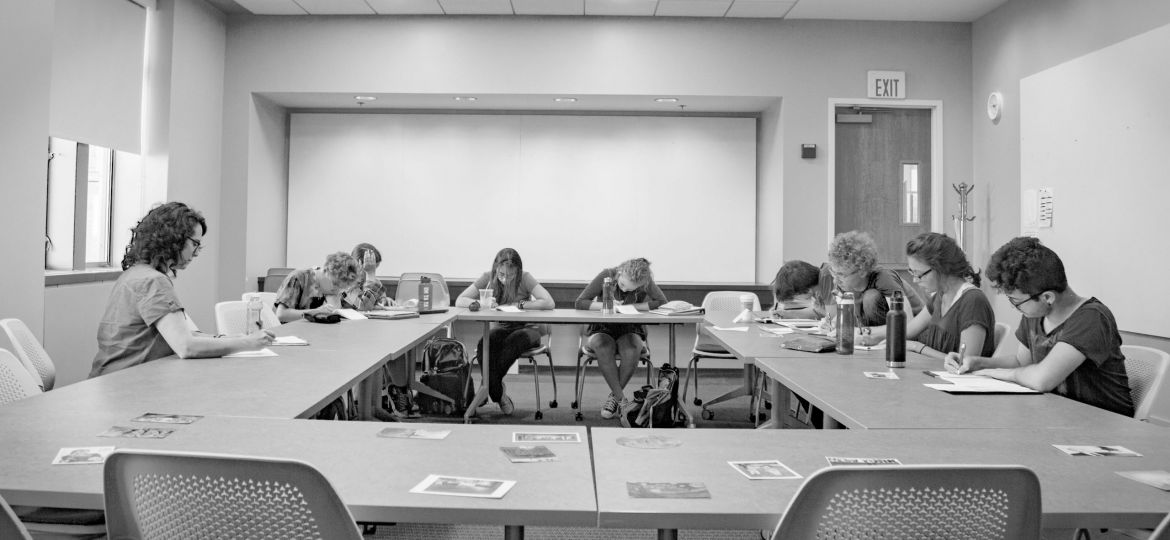
Sept. 12, a small conference room in Buntrock. Eight heads are bowed, furiously scribbling over miniature steno pads, ideas streaming from head to pen to paper. One dark, curly-haired head watches over the other eight, occasionally offering a gentle prompt to keep the ideas flowing.
This is Carson Kreitzer: history enthusiast, Minneapolis resident, self-proclaimed “theatrical magpie” and last but not least, playwright.
Kreitzer was welcomed to the St. Olaf community officially on Sept. 12, but her ideas have been mingling with Oles for quite a while now, as preparations for the Theater Department’s first fall production have begun. For the first play of the year, director Karen Peterson Wilson ’77 selected Kreitzer’s “Be Here Now,” a ‘lyrical’ play with a six person cast.
On this particular September afternoon, Kreitzer joined St. Olaf students to lead a playwriting workshop. She began by getting to know the students in attendance, inquiring on their previous experience with playwriting and theater in general. She was also extremely genuine in asking about various interests that students held, eager to explore playwriting on a personal level with each individual.
From there, Kreitzer instructed stu- dents to make a series of lists: people they knew, places where two people could meet, characters and random objects. All brainstorming was set under a strict time limit, adding a particular charge to the room that might be described as a combination of pure panic and inspired tension.
Although perhaps a touch overwhelming, the time limit demanded that students let their ideas fly with no hesitation or contemplation over the particular quality of their work. The limitation turned out to be a liberation.
In fact, when asked about her profession, Kreitzer admitted that “a lot of the trick of writing is to shut down the voice that says ‘I can’t do this!’” She told her small clan of attentive learners to “not be constrained by the smallness of the paper.”
Holding firm to this advice, students were then freed (under another time limit of course) to write a short scene, then a short dialogue, pulling inspiration from their aforementioned brainstorm lists. But of course, this is creative writing, so yet another twist was thrown in: select a post card that speaks to you and find part of your story from within the colorful image.
The results? Pieces that were certainly a little rough around the edges, but unique and clever and creative nonetheless. Students embraced each other’s work, offering praises and asking questions, analyzing the rough sketches of stories born only moments earlier.
Not too shabby for a group comprised of students whose theater experiences ranged from acting to stage managing to playwriting and beyond. The mixed array of theater experience seemed quite relevant for Kreitzer, who was pleased to find that so many stu-
dents were experimenting with different elements of theater. She herself did not discover playwriting until late in her college career, after dabbling in just about every other position one could try. She repeatedly encouraged students to try everything that theater has to offer, telling them to “learn from all the different angles.”
Following the workshop, Kreitzer remained on campus for the rest of the evening as well as the next day. She hosted an informal lunch to answer further questions about her profession, visited various theater classes, and sat in on a rehearsal of “Be Here Now.”
When asked to describe the work, assistant director Aaron C. Lauby ’19 explained that “‘Be Here Now’ follows three sisters as they learn to be settled in themselves and their situation. It is truly a play that speaks to young people in the modern world.” Lauby, who has plenty of previous directing experience, added that “Be Here Now” is particularly intriguing to him, as it is a new, unpublished script.
On working with Kreitzer, Lauby was thrilled to have the “truly unique experience” of meeting the mastermind behind the department’s fall project.
“Hearing from Carson really seemed to affirm Karen Wilson’s vision and allowed us all to breathe freer knowing that Carson didn’t have a strict idea of how the show had to be done,” Lauby said.

